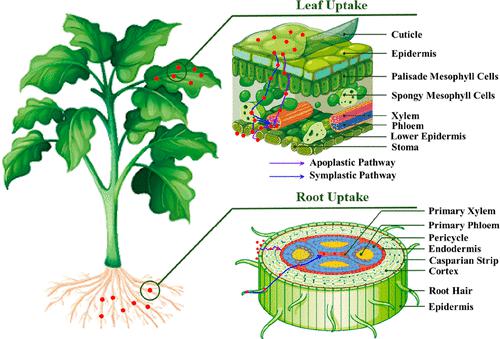当前位置:
X-MOL 学术
›
Environ. Sci. Technol. Lett.
›
论文详情
Our official English website, www.x-mol.net, welcomes your
feedback! (Note: you will need to create a separate account there.)
Leafy Vegetable Assimilation of Atmospheric Microplastics/Nanoplastics: An Overlooked Source in Human Food?
Environmental Science & Technology Letters ( IF 8.9 ) Pub Date : 2024-01-03 , DOI: 10.1021/acs.estlett.3c00887
Jun Zhou 1, 2, 3 , Ruizhi Xia 1, 3
Environmental Science & Technology Letters ( IF 8.9 ) Pub Date : 2024-01-03 , DOI: 10.1021/acs.estlett.3c00887
Jun Zhou 1, 2, 3 , Ruizhi Xia 1, 3
Affiliation

|
With the rapid development of the global economy, plastic production has steadily increased over the past six decades and reached 367 Mt in 2020. Microplastics/nanoplastics [termed micro(nano)plastics] have become a significant global pollutant in terrestrial and aquatic environments worldwide due to their widespread use and improper management and disposal. A recent study by Fu et al. (1) suggested that the global atmospheric emission of microplastics is 0.32 Mt year–1, while similar ocean and terrestrial sources are estimated to be 0.17 and 0.15 Mt year–1, respectively. Road-related sources (0.115 Mt year–1) and agricultural activities (0.038 Mt year–1) are considered the dominant terrestrial emission sources of atmospheric micro(nano)plastics. The largest deposition of agricultural microplastics occurred near the world’s largest agricultural regions due to the limited transport caused by the large particle/fiber sizes. Furthermore, micro(nano)plastics with lower particle densities can be transported far from anthropogenic emissions, potentially leading to the contamination of rural agricultural lands. Plant leaves with uneven surfaces and large stomatal size (typically open pores ranging from 5.5 to 23 μm) can absorb atmospheric particulate matter (PM) and serve as important sinks for various atmospheric pollutants (Figure 1). This includes micro(nano)plastics, which share many common properties with atmospheric PM, such as size and aerodynamic characteristics, and have even been found in PM samples. For the foliar assimilation of PM, hydrophilic substances can penetrate the cuticle through stomata and aqueous pores, while lipophilic substances diffuse through the cuticle. However, there could be significant differences in the physicochemical characteristics and behavior of PM and micro(nano)plastics, which may affect their pathways of foliar assimilation and fate distribution. The lipophilic surface characteristics of micro(nano)plastics have a stronger affinity for the leaf wax layer. Additionally, their irregular shapes (such as microfibers and microthin films) and small particle size make it easier for them to be absorbed by trichomes on leaves. Although concentrations of micro(nano)plastics in the atmosphere are much lower than those in soils, atmospheric deposition can continuously accumulate on the leaf surface. Additionally, short-term precipitation can wash large quantities of micro(nano)plastics from the air onto the surface of leaves. (2) Rinsing with water cannot completely remove the sprayed micro(nano)plastics from the crop leaves. Therefore, rainfall may contribute to the accumulation of more micro(nano)plastics on vegetable leaves. Figure 1. Schematic diagram of the possible assimilation of atmospheric microplastics/nanoplastics via plant leaves and roots. Generally, root uptake is considered the primary pathway for pollutants in plants (Figure 1). A recent review study suggested that crop plants can assimilate nanoplastics (ranging from 1 nm to 1 μm) through the crack-entry mode at sites of lateral root emergence and transport them to different tissues. However, the efficiency of assimilation and transport is largely dependent on the size of the nanoplastics. (2) Nanoplastics with diameters of >100 nm cannot be endocytosed by cells because the capacity of endocytic vesicles is too small to be able to internalize such large nanoplastics. Additionally, large nanoplastics cannot penetrate the firm cellulose cell walls or pectin networks. Therefore, the uptake of large nanoplastics (>100 nm) and microplastics by plant roots and their subsequent transport are limited to the shoots, specifically the edible parts of leafy vegetables. Similarly, both nanoplastics and microplastics can accumulate in stomatal guard cells. However, only small (<100 nm) nanoplastics can penetrate into the leaf interior through stomatal and cuticular pathways, while microplastics primarily adhere to the leaf epidermis. Nanoplastics can penetrate leaf cell membranes, most likely through plasmodesmata or endocytosis. Subsequently, they can be transported to mesophyll cells and eventually reach the leaf vascular bundle, moving down to the roots through a symplastic pathway (Figure 1) A significant number of microplastics (mean of 3.62 ± 1.29 items cm–2) were found on the leaf epidermis in urban, suburban, and rural areas of a megacity. After the leaves had been rinsed with deionized water, it was observed that these microplastics were mostly smaller than 80 μm, ranging from 9 to 2464 μm. (3) In terms of micro(nano)plastic contamination in the edible parts of crops, particularly leafy vegetables, foliar assimilation may be a more significant source compared to root assimilation. However, the exact processes are not yet fully understood. More research is needed on the interaction of micro(nano)plastics with leaves and their translocation within plants to more accurately assess the impact of atmospheric micro(nano)plastics on agricultural ecosystems. Humans are exposed to micro(nano)plastics through various pathways, including direct ingestion of food and drinking water, as well as inhalation. The presence of micro(nano)plastics in food chains has recently been documented, and microparticles were found in human thrombi. (4) Micro(nano)plastics have been reported in seafood, drinking water, and table salt in numerous studies. Leafy vegetables, due to their large surface area, can directly assimilate micro(nano)plastics that are deposited on their surfaces, and consuming these vegetables becomes an important source of dietary micro(nano)plastic intake. However, this has never been considered. In contrast, nanoparticles were found to be translocated from plant tissues to the chaff, which promoted their accumulation in the aleurone layer of rice, but they cannot reach the polished rice, so that cereal consumption would be not a source of dietary intake of micro(nano)plastics. In conclusion, crop shoots may play a key role in the assimilation of atmospheric micro(nano)plastics. Leafy vegetable consumption should be considered an important dietary source of micro(nano)plastics, which has been overlooked in research on human exposure to microplastics. In Spain, the presence of micro(nano)plastics found in sheep feces, after the animals have grazed on vegetable residues in the fields, suggests that animals may ingest micro(nano)plastics through their consumption of grass or vegetables. (5) Understanding the capture capacities of various vegetables for micro(nano)plastics can assist in mitigating atmospheric microplastic pollution and reducing human exposure. Vegetable assimilation of atmospheric microplastics and the risks to human health deserve more attention. Jun Zhou is an environmental geoscientist based at the Institute of Soil Science, Chinese Academy of Sciences, China. Utilizing a tower-based flux-gradient approach, a dynamic flux chamber, precipitation and dust collection, stable isotopes of cadmium and mercury, diffusive gradients in thin films (DGT), and other state-of-the-art techniques, his research primarily focuses on the exchange fluxes of heavy metals between the atmosphere and the earth’s surface, surface processes, and prevention of pollution risks. He graduated in 2016 with a Ph.D. in environmental science from the Research Center for Eco-Environment Sciences at the Chinese Academy of Sciences, China. He held an assistant professor position at the Institute of Soil Science, Chinese Academy of Sciences, for three years and a postdoctoral position at the University of Massachusetts, Lowell, USA, for an additional three years. Since March 2023, he has been a professor at the Institute of Soil Science, Chinese Academy of Sciences. Now, he primarily focuses on heavy metal and emerging pollutant deposition and soil remediation in agricultural systems. Additionally, he focuses on the exchanges of mercury and PFAS between the surface and the atmosphere in forest ecosystems. This work was financially supported by the National Natural Science Foundation of China (42177234 and 42377032) and the Jiangxi Provincial Natural Science Foundation (20232ACB213016). This article references 5 other publications. This article has not yet been cited by other publications. Figure 1. Schematic diagram of the possible assimilation of atmospheric microplastics/nanoplastics via plant leaves and roots. Jun Zhou is an environmental geoscientist based at the Institute of Soil Science, Chinese Academy of Sciences, China. Utilizing a tower-based flux-gradient approach, a dynamic flux chamber, precipitation and dust collection, stable isotopes of cadmium and mercury, diffusive gradients in thin films (DGT), and other state-of-the-art techniques, his research primarily focuses on the exchange fluxes of heavy metals between the atmosphere and the earth’s surface, surface processes, and prevention of pollution risks. He graduated in 2016 with a Ph.D. in environmental science from the Research Center for Eco-Environment Sciences at the Chinese Academy of Sciences, China. He held an assistant professor position at the Institute of Soil Science, Chinese Academy of Sciences, for three years and a postdoctoral position at the University of Massachusetts, Lowell, USA, for an additional three years. Since March 2023, he has been a professor at the Institute of Soil Science, Chinese Academy of Sciences. Now, he primarily focuses on heavy metal and emerging pollutant deposition and soil remediation in agricultural systems. Additionally, he focuses on the exchanges of mercury and PFAS between the surface and the atmosphere in forest ecosystems. This article references 5 other publications.
更新日期:2024-01-03































 京公网安备 11010802027423号
京公网安备 11010802027423号